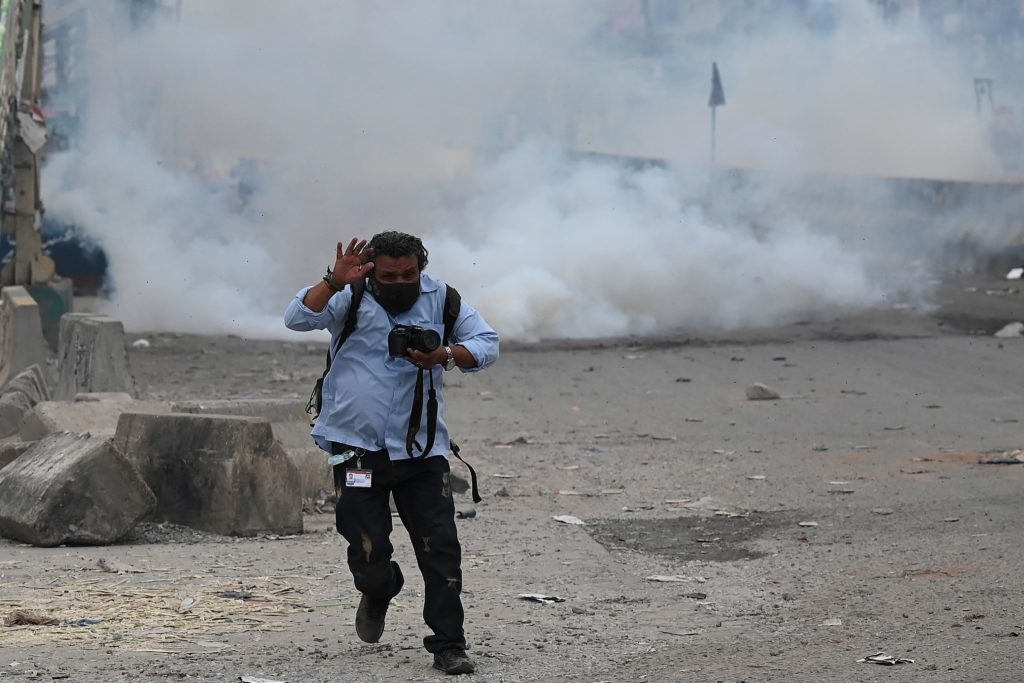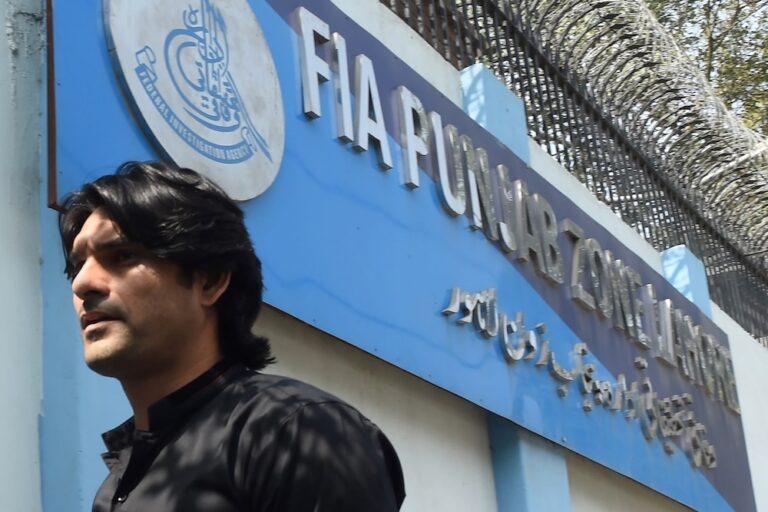On 8 November, Pakistan's National Assembly unanimously passed the Protection of Journalists and Media Professionals Bill, 2021. Learn about how the Pakistan Press Foundation and its partners laid the groundwork for this welcome achievement.
Editor's Note: We originally published this Campaign Snapshot in August 2021, to mark the passing of a landmark journalists' safety bill in Pakistan, in the province of Sindh. Our hope that this would be followed by the passage of a national bill was realized on 8 November. Read more about that development here.
The IFEX network of over 100 member organisations in over 60 countries is committed to the power of collaboration. That same commitment is behind this occasional series of IFEX member campaign snapshots; to share some of the creative campaigns members have been working on, so others can learn from their experiences. You can see them all here.
The recent passage of the Sindh Protection of Journalists and Other Media Practitioners Act 2021 is the culmination of years of hard, sustained work by individuals and groups inside and allies outside of the country. The goal? To create a safer work environment for the media in Pakistan and to ensure accountability of those who attack journalists.
IFEX spoke to Owais Aslam Ali, Secretary General of IFEX member the Pakistan Press Foundation (PPF) about their work promoting and maintaining momentum for the passage of the country’s first-ever legislation on journalists’ protection, and what’s next on the agenda. Below, Owais describes this work.
THE SPARK
Here in Pakistan, the environment journalists operate in is both restrictive and unsafe. They face physical attacks, threats, censorship, and restrictions on all fronts. Meanwhile, in the overwhelming majority of cases, the perpetrators of these attacks enjoy impunity. Despite this, Pakistan had no law specifically focused on the safety of journalists.
In February 2020, a draft Protection of Journalists and Media Professional Bill 2020 was presented to the federal cabinet. However, the cabinet stopped short of formally approving the draft bill, instead giving approval to fold it in with an earlier bill prepared by the information ministry.
This delay was an opportunity for civil society; it gave us time to discuss and improve upon the legislation.
THE CAMPAIGN
In a series of consultative sessions we organized we were able to hear from various stakeholders, including journalists, other civil society organizations, media bodies, and lawyers. This involved a clause-by-clause review of the draft bill, as well as a review by international experts – following which a policy paper of the recommendations was prepared by PPF.
Next, we began lobbying political leadership from across party lines in an attempt to encourage the earliest possible passage of the bill. We met with members of the Senate and National Assembly, as well as with Pakistan’s president, Dr. Arif Alvi. A positive outcome of the lobbying process was that the leadership from the ruling party of the province of Sindh said that they were interested in presenting a similar bill, at the provincial level.
This opened a new door for us. Even if there was a delay at the federal level, the process could begin with provincial legislation. The impact, beyond setting a precedent, would be significant; Sindh has a population of over 47.9 million and is the largest media centre of the country.
PPF prepared a draft bill for Sindh, based on the federal bill. A second stage of consultations were organised, this time by the Sindh government. These were physical meetings in the office of the Secretary, Information Department. The Sindh government selected the participants, which included representatives from PPF, the Pakistan Federal Union of Journalists (PFUJ), the Council of Pakistan Newspaper Editors (CPNE), the Karachi Press Club, and two senior journalists: Mazhar Abbas and Qazi Asif.
The bill was then presented before the Sindh Assembly on May 21, and passed unanimously on May 28.
There was a last-minute obstacle: the provincial governor refused to sign off on the bill. However, once again it was presented in the assembly, and this time it became law. The governor finally signed the bill on July 31.
It is a landmark law, and one which also undertakes to implement the United Nations Plan of Action on the Safety of Journalists and the Issue of Impunity. The inclusion of elements such as ensuring professional privacy of journalists marks a big step forward in ensuring the safety of media, when the law is implemented.
CAMPAIGN PARTNERS AND ALLIES
This legislation has been a collective effort from the very first. It was the federal government that began the momentum, with its draft bill, and we are still hopeful that it will be passed soon.
The bill for Sindh was based on the federal bill, which had gone through a series of consultations with civil society, journalists, media bodies, and lawyers. The Sindh draft bill then went through a second round of consultations – which the Sindh government led, but took a backseat in, creating space for the voices of journalists and media bodies.
The Sindh law would not have been possible without the commitment of organisations such as the Pakistan Federal Union of Journalists (PFUJ), the Council of Pakistan Newspaper Editors (CPNE) and the Karachi Press Club.
HIGHLIGHTS
The consultation process was very successful. In the first stage, consultations were organised by PPF and were held online, using Zoom. We wanted all key stakeholders on board.The response from these individuals was overwhelmingly positive. They not only contributed their time, they also adapted to the circumstances set by the spread of COVID-19 and agreed to online consultative sessions.
Women from various fields of expertise were part of those consultations, and provided vital feedback on all sections of the draft bill including sections specifically referring to the abuse and harassment women journalists experience. Participants included leading women journalists, human rights activists, and lawyers, all of whom greatly added to the conversations and ensured that the recommendations were inclusive and addressed the concerns of women journalists.
Another highlight was the enthusiasm of the Sindh government for the idea of passing a provincial bill, and the speed with which, within months of initial conversations, this bill became law.
KEY CHALLENGES
Given the pandemic, consultations on the federal draft bill had to be virtual. Of course, such sessions would have been even better in person, given the ability to discuss without connectivity issues, Zoom fatigue, and other such issues. However, given the circumstances, stakeholders not only were willing; they very actively participated in these sessions, and patiently maneuvered through any delays caused by the virtual sessions.
One of our biggest obstacles came very late in the process, when the provincial governor expressed reservations and refused to sign off on the bill. Fortunately, it was only a temporary delay. When the bill was presented before the provincial assembly a second time, it was passed. Once the bill was passed again before the assembly, the governor also signed off on it.
Now that we have this law, the challenge is to ensure that it is implemented, and that it is effective. This will include the constitution of The Commission for Protection of Journalists and Other Media Professionals; lobbying for effective rules and regulations for this commission; and then monitoring the performance of the Sindh Government as well as this Commission.
LESSONS LEARNED
- Persistence is key: Getting legislation for the protection of journalists passed at any level – federal or provincial – takes years. What started as calls for accountability and coverage of the dangerous landscape media in Pakistan operate under resulted in the first such legislation.
- Be open to changing course: While the process began with a focus on improving a federal level draft bill, which we will continue working on, it evolved into one province passing their own law.
- Work with others: The main takeaway from the process has been to remain focused on the goal and working with as many partners as needed to ensure that such drafts turn into actual law. The recommendations put forth by other stakeholders are what resulted in a much improved bill for the provincial level. It was by lobbying with government members that the idea of a Sindh level bill came about.
- Be low key: Let others take the limelight in meetings, consultations and in public statements. Do not let egos get in the way of achieving the goal.
WHAT’S NEXT?
- The most immediate goal is to ensure that this law becomes active and is implemented, once the rules and regulations for it are decided upon. That relies on awareness and understanding. PPF hopes to work on informing journalists in the province and providing them with the necessary training to know about the legal protection that they are now able to access.
- Beyond the legislation for Sindh, we hope that this law will further encourage the federal government to discuss and pass the draft bill for journalists’ safety that has been presented in the National Assembly.
- Like Sindh, other provinces should follow suit and introduce their own legislation. Two out of Pakistan’s four province – Khyber Pakhtunkhwa and Punjab – have shown interest in doing so, and we hope to see this process take place.
- The Sindh journalist’s protection act provides a mechanism to effectively implement laws that are already on the books. There are discussions about why journalists deserve unique treatment over others who are harassed, attacked, or murdered. This law thus does not propose stricter punishments, or add to the list of crimes – it simply provides a mechanism for existing laws to be implemented.
- Sexual harassment is pervasive in Pakistan, and female journalists and media workers have to contend with it in both digital and physical work spaces. The Sindh law makes it the responsibility of The Commission for Protection of Journalists and Other Media Professionals to look into complaints of sexual harassment, violence, and threats of violence, and to monitor the investigations of all acts of sexual harassment. Another area of research now could be gathering provisions of existing laws that can be used to promote the safety of women media practitioners and hold to account those who flout those laws.



